In this article on Tai Ji Quan I have chosen as point of departure my own experience with the art. As such it is not a theoretical discussion on the art of Tai Ji Quan. As I assume the reader has some basic knowledge of Tai Ji Quan and similar Martial arts, familiarity with basic concepts and principles of these arts will be taken for granted.
Starting off…
Out of curiosity and not yet fully committed to the Quest, I started out on my Tai Ji Quan Journey in 1987 by taking lessons in the Yang style from a Danish teacher who was a student of Master Chu King Hung. Master Chu King Hung is a student of Yang Shao Shung and he is also a skilled Xing Yi Master. From 1988 to 1990 I received lessons directly from Master Chu. Whereas I was less than fully committed in the beginning, my interest in Tai Ji Quan strengthened around 1990 and has been persistent ever since.
In these initial years my knowledge of Tai Ji Quan was obviously quite limited. Due to the lack of actual knowledge and in accordance with the rise of the New Age movement there was, at least in Denmark, a tendency to shroud Tai Ji Quan in a veil of mysticism and make believe. Not so from the Masters who frequently visited Denmark to teach – Masters Kai Ying Dong, Chu King Hung and others, but especially from some of the Danish teachers. These unfortunates were compensating for their lack of actual knowledge with tales of mysteries and secrets.
Some of these stories related how Tai Ji Quan was a Panacea and contained the answer to all of life’s questions. Likewise stories circulated of how one should practice the Tai Ji Quan form, facing this or that way, 20 or 30 times at various times during the day in order to excel in the art. All of this was probably natural, considering Tai Ji Quan in Denmark at that time was in its infancy. The will to practice and learn was abundant, but the actual knowledge was limited.
Acknowledging this to be the case I quickly realized that if I really wanted to gain an understanding of, and proficiency in, the art of Tai Ji Quan it would take a lot of ground breaking effort on my part. It would require an open mind, studying the Classics and the related Martial arts and the willingness to start as a beginner every time I met a new teacher. And first and foremost, of cause – a stern commitment, physical as well as mental.
After a few years studying with Master Chu King Hung followed by a brief encounter with Master Kai Ying Dong’s Yang style, I was fortunate enough to meet Chen Guan Ming, who taught Lao Jia Chen Style Tai Ji Quan. He stayed in Copenhagen twice and I took lessons from him on both occasions in the early nineties. Later my Tai Ji Quan friend Tal Rosenzweig went to Shanghai and established contact to Chen Guan Ming’s teacher, Master He Gong De. Master He Gong De was one of Master Chen Zhaokuis close students and he had also studied with Master Feng Zhi Qiang for an extended period. In addition he had practiced Tui Shou with renowned Yang style master Chen Wei Ming, who was one of Yang Cheng Fu’s close students. From 1994, when I first met with Master He Gong De, and to his death in 1999, I developed a close relationship with him and he accepted me as his disciple. In 1998 I met Masters Yek Sing Ong and Wee Kee Jin, both close students of Master Huang Xiang Xian. From 1999 – 2007 I was a close, private student of Wee Kee Jin, and continued having briefly contact to Yek Sing Ong and visited him whenever I was in New Zealand.
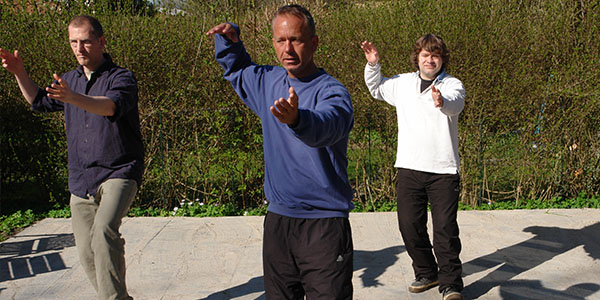
2001: Private teaching situation at Torbens house.
In 2005, after a year of corresponding, I succeeded in bringing Yang style and Yi Quan Master Sam Tam to Copenhagen, where he taught at a workshop – and he have been here many, many times since that. On my first visit to master Sam Tam, I went there together with my former teacher Wee Kee Jin, WHO himself ended up being a student from master Tam for a couple of years.
Since his first visit to Copenhagen I have visited Master Sam Tam for quite some times in his home in Vancouver and received teachings from him. Today I consider him to be my main teacher and I am thank full for his willingness to teach me.
Besides my main teachers mentioned above, I have learned for longer or shorter periods from the following masters – Patrick Kelly, James Lau King, Jeng, Shen Shen Yuan, Wu, Shu and a few others – all of them close students of Master Huang. Together with Wee Kee Jin and several of his students I have traveled around in Malaysia, visiting Master Huangs schools. I have also met and learned from Master Feng Zhi Qiang, Peter Ralston, master William Chen among others.
I mention my teachers, past and present, for a number of reasons.
Having several teachers
I believe it is necessary to have more than one teacher, if you want to continue developing your Tai Ji Quan skills. Initially one should visit different teachers, ask about their background, maybe talk to some of their students and try, if possible, to take a lesson or two before committing to the classes. When you have chosen a teacher, hopefully the right one, you have to commit yourself to the instructions of that teacher until the basic concepts of Tai Ji Quan are understood and integrated. This will probably mean an initial period of several years.
In the search for a teacher it is important to realize what you want from practicing Tai Ji Quan. Do you seek health benefits, martial prowess, decrease of physical and mental stress, something else, or all of it? What ever it is you are trying to gain from Tai Ji Quan you should make sure that the teacher masters it himself, and is willing to teach it to his students. Today there is a fair amount of good teachers worldwide, so it is definitely possible to receive good and reliable instructions.
It is also a good idea to read a few books on Tai Ji Quan and related subjects. Get your teacher to recommend some books – unfortunately there is an abundance of very poor books on the subject, so guidance will save you a lot of time. If your interest in the art does not fade there will, after some years of committed practice, come a time when it would be a good idea to seek other teachers. But this point is only reached when your practice have given you a thorough understanding of the system you have been a student of. When a new teacher is found it is essential that you consider yourself a beginner, otherwise the new teacher will not be able to teach you. You will have to “empty your cup” in order to receive new knowledge. In regards to Tai Ji Quan it is essential that you always consider yourself a student. No matter how long you have been practicing, it is always possible to improve your skill. There is no end to the art.
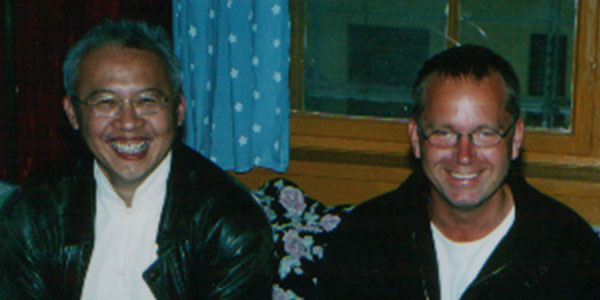
2006: Wee Kee Jin and Torben joking around.
I have always accepted this role and thereby given my teachers an opportunity to teach me, instead of showing what I already had mastered, making comparisons and so forth. In this connection I would like to mention that my good friend and former teacher, Wee Kee Jin like me chose to take lessons from Sam Tam and considered himself a beginner in Sam Tam’s system. Looking back at the great masters of the past you would often find that they have had several teachers and more often than not, they also studied other systems than Tai Ji Quan, internal as well as external. In this respect Tai Ji Quan is no different than other knowledge we acquire during life. Few of us would probably choose to stick to our teacher from Primary school as we grow older.
If the interest is keen and the commitment firm, the need to learn from several teachers will inevitably arise if the student is to advance. But it is a gradual development, in order to benefit from a new teachers instructions the student must have acquired the proper level of understanding. And even with a gifted student and a skilled master this takes time, indeed it should take time – slow is fast and fast is slow.
The importance of touch
This article was not meant to deal exclusively with the teacher/student relationship, even though there is a lot to be said on that subject. Equally important is the way the teaching is conducted. If your teacher wraps Tai Ji Quan in mysticism, elusive knowledge and tales of secrecy you may rest assured that he has a very limited understanding, if any, of the subject. Tai Ji Quan is no mystery and there are no secrets!
Everything can be explained and demonstrated, provided the teacher has the proper level. But it takes time to reach that level of skill. Initially you have an intellectual understanding of the principles and with diligent practice it will slowly be absorbed by the body. Time after time I have received corrections from my teachers which it subsequently has taken me months and years to integrate physically. But at the time they were given it only took me a moment to understand them intellectually. And in this connection touch is crucial.
In the older Tai Ji Quan literature you often encounter the expression “secret transmission”. Everyone who has practiced an internal martial art has probably heard of these Secrets. Maybe you have yourself had the “luck” to receive such secret transmissions from teachers who were fortunate enough to posses them. But there are no secrets, and if you one day happen to meet a teacher who claims otherwise you will do well to seek guidance elsewhere.
There are only two secrets: Touch and practice!
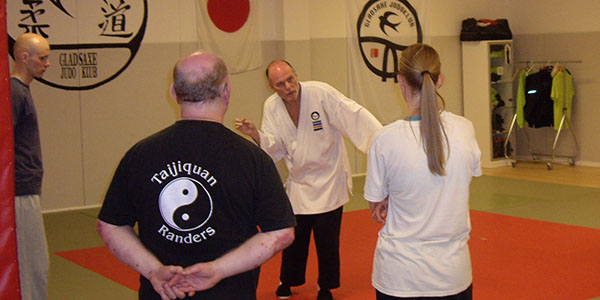
2012: Peter Ralston trying to get through to the students during a workshop in Copenhagen.
Back in the days only the “indoor” (Ru Men) students were allowed to touch the master’s body, in order to feel the physical changes taking place while yielding, sinking etc. This would give the disciple a tangible idea of what to aim for in his practice. This “hands on” teaching method was often referred to as a “secret transmission” as it was reserved for the close students. Without it, it is extremely difficult, if not impossible to fully comprehend and master Tai Ji Quan or any other kind of internal martial art. The Form is just a frame, the outside or surface of the art. It is the internal changes in the form and the work with them that is the essence. These changes and the power they yield can not be understood without touching a master who can command them. Trying to gain an understanding of this through reading or listening to a lecture, is as absurd as trying to taste a plum by looking at a picture of one. You could read the classics every day and practice diligently for 100 years and you still would not get it. So if you meet a teacher who will not let you feel his body he is either unable or unwilling to teach Tai Ji Quan.
And as time goes on and you slowly proceed from the superficial level to the profound the importance of touch increases. When I am being taught by my teachers we are more or less constantly in physical contact. During my latest visit to Sam Tam I was almost constantly in physical contact with him, except from the time I was in midair between him and the mattress on his wall. When Wee Kee Jin used to stay with me in my house, we always practiced pushing hands and related exercises, 2 – 4 hours a day, not including the practice that took place at his workshop. Physical contact is of paramount importance if you really want to learn Tai Ji Quan. Anything else is just monkey see monkey do, and will amount to nothing even remotely close to an internal martial art. For this reason alone you can not justly call yourself teacher of Tai Ji Quan unless you have received hours of instruction on this one on one basis.
Tai Ji Quan is not Aerobic, dancing or some spiritual ritual. As responsible teachers of the art we need to limit our teaching to things we have been thoroughly instructed in by skilled masters. If we teach Tai Ji Quan with no deeper understanding than forms and exercises we are not honoring the art and we will be deceiving our pupils.
Forms
A recurrent statement in Tai Ji Quan literature is “Everything is in the Form”. This is basically true; a correctly transmitted Form does contain all the fundamental principles of Tai Ji Quan. Sadly, a vast number of Teachers, and consequently their students, do not work with or acknowledge the existence of said principles. This is a deplorable fact and one of the reasons why Tai Ji Quan as a martial art is on the brink of extinction – along with similar internal martial arts such as Yi Quan and Ba Gua Zhang. The Form should never be made to be more than it is: a tool to help you understand the basic principles of Tai Ji Quan and as a channel for the Teacher to pass on his knowledge.
The same thing applies to Zhan Zhuang or Standing Meditation. As my teacher Master Sam Tam said to me recently when we were discussing Zhan Zhuang practice: “You must remember that the Standing is there to serve you – you are not there to serve the standing”. This remark illustrates the fact that Zhan Zhuang, the Tai Ji Quan forms and various related exercises are mere tools to help obtain skills and ease the understanding of principles – which then has to become an integrated part of every movement. The object of the practice of Standing Meditation, Zhan Zhuang, is not endurance (“for how long can I remain in this position”?) and regarding Forms; it is not very important what specific set pattern of movements you practice. As Zhuangzi states in the chapter “External Things”: “The fish trap exists because of the fish, once you’ve gotten the fish you can forget about the trap”.
Do not think of the Form as something sacred, handed down from antiquity, imbued with the knowledge of the ancient masters – an enigmatic wonder that has to be practised in a specific way in order to yield its hidden knowledge. Actually the practice of set patterns or Forms, is a relatively recent thing in Tai Ji Quan, probably no more than a couple of hundred years old, whereas the art itself has roots that go much further back. But while Form practice has been a part of Tai Ji Quan, the Form has never been a rigid thing. Every Master has, deliberately or unconsciously, left his individual mark on the set of movements he received from his own Master. Obviously the various Forms have also been influenced by related martial arts, hard as well as soft, internal as well as external. In time this has created a multitude of differing forms, all rooted in the original “SanShi Shi” – the 13 methods.
And that is the natural state of things. Like all other tings the Form is impermanent. It has to change according to the level of understanding at any given time, otherwise it will be nothing but a static prison for the student and there will be no progress. The Form is the outer shape the principles of Tai ji Quan may assume, and as such it is not important which Form you practice – if it’s the Yang, Wu, Chen or Sun style. But it is important that you practice in accordance with the Tai Ji Quan principles as they are found in the classics, and it is obviously important that your teacher understands these principles and is able and willing to pass it on to you. Some systems may eventually prove to be developing the student faster than others – but that’s another story.
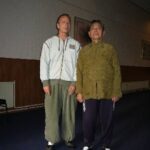
Master Feng Zhigiang and Torben, 2006 or 2007.
Why do Standing/Zhan Zhuang?
Zhan Zhuang or Standing Meditation; the exercise of keeping a certain posture for an amount of time – ranging from a few minutes to an hour or more, is a basic exercise in most Tai Ji Quan systems and in Xing Yi, Yi Quan and Ba Gua Zhang as well. In the Tai Ji Quan lineage it was mostly the “Ru men” students who where taught Zhan Zhuang. The only teacher of mine who did not practice Zhan Zhuang was Patrick Kelly, but both his teachers; Huang Xiang Xian and Ma Yue Liang practiced and taught Zhan Zhuang. Feng Zhi Qiang has practised a great deal of Zhan Zhuang, Wee Kee Jin does it a lot and it is the basis of Sam Tam’s system. Zhan Zhuang is practiced in a variety of way and the goals of the practice vary. In the following I will outline a few of the goals.
Primarily Standing Meditation is practiced in order to achieve a connected body structure as opposed to a segmented or unconnected body structure. The connected body structure is a prerequisite for the achievement of whole body power – the effortless transmission of power from feet to hands. An important part of working on the connected body structure is the alignment of the Pelvis. In order to align the Pelvis and thus straitening the back, tension around the Coccyx must be released. This will allow the Coccyx and the Pelvis to align naturally with the gravity of the body structure. It is often said that the Pelvis should be tucked under, in order to straighten the back. I believe this is wrong as it creates an unnatural tension in the Pelvic area instead of relaxing it.
And the ability to release unnecessary tension is essential if one is to gain anything from the practice of Standing Meditation – “don’t fight yourself when you stand” Sam Tam says. Otherwise the practitioner will just be building up tension, stiffening the body and breaking it up into segments, achieving the complete opposite of the initial goal. None the less, some Tai Ji Quan and Yi Quan teachers are primarily focused on the duration of the exercise, emphasizing the physical and mental endurance of the practitioner instead of the quality of the exercise. Standing Meditation is an exercise that demands a lot from the student, both physically and mentally and it is rarely suitable for the beginner, an exception being the Wu Qi standing. Only when the student through other exercises has learned to work with the releasing of muscle tensions and the ability to practice mindfully is the time right for this exercise.
Maybe the most important aspect of the Standing Meditation is the integration of Mind and Body through introverted attention. The student must learn how to observe the body structure with an open and attentive mind, feeling the weight distribution, balance, sensitivity and tension pattern in the body.This attentive observing can then be used actively to correct any imbalances, increasing sensitivity and releasing tensions, for instance by visualizing a flow of melting warmth that releases tensions and restores balance in an imbalanced area of the body.
Any distracting thoughts are not subdued by focusing on external things such as light or objects, but simply accepted and neutralized by not giving them any further attention and letting them pass by on the river of consciousness. At a higher level the student will be working with this open mindfulness and interchanging it with a strong focus on obtaining certain specific skills.
As I suggested above it is important not to make the Standing Meditation or its duration a goal in itself. It should be instrumental in the development, comprehension and integration of basic principles in Tai Ji Quan. As such there are a variety of different Standing Meditation exercises that aim at achieving these goals. Amongst these it is futile to try and single one out as being the superior exercise. The usefulness of the exercise depends on the teachers approach, the student’s background and what specific skill the exercise is supposed to help developing.
The qualities we seek to refine when we are doing the Standing Meditation should also be present when we start to move. But the Standing Meditation is, with its lack of movement, an easier place to refine subtle skills than the form or other exercises that are performed in motion. Having said this it is important to remember that even though the Standing Meditation is confined to one position, it is by no means locked in that position. During the exercise slight adjustments will continuously occur in the bodily structure of the practitioner, some consciously sought, while others come by themselves.
To the on looker unfamiliar with this kind of practice, it would seem that the person doing the Zhan Zhuang is indeed standing still as a post. But the skilled practitioner will notice the minute changes taking place. Remember “In stillness there is movement and in movement there is stillness”. The integration of body and mind that is sought in the Standing Meditation should also be made part of the Form. In this transition between the seemingly immobility of the Zhan Zhuang to the fluency of the Form, Master Huangs Xiang Xian’s 5 relaxing exercises are very helpful. Obviously there is an abundance of exercises that can help in this process, but of all the different exercises I have come across during the years the 5 relaxing exercises are the most complete.
Chen Style Tai Ji Quan has the “Silk reeling” exercises and Master Feng Zhi Qiang has developed his own equivalent of these, many of which are excellent. Master Sam Tam also does exercises, partly from Yi Quan and partly from Yang Style Tai Ji Quan. Master Huangs 5 relaxing exercises are really exceptionally well put together, having been tested and developed for a period of more than 40 years. Each one of them contributes to the understanding and integration of the basic Tai Ji Quan principles. As excellent as these exercises are, it is important to realize that they themselves are not the goal. They were meant to help develop the students understanding and skill and should not end up being a trap for his mind.
Basic principles of Tai Ji Quan
The basic principles of Tai Ji Quan, the principles that are unique for this martial art and thus separate it from other martial arts, internal or external, are neither secret, mysterious nor unattainable. Generally they are easy to understand intellectually but hard to put into real life practice, both mentally and physically. To do this takes a lot of time and effort.
In the following I will go though a few of these basic principles. As I mentioned earlier it is crucial to make the body a functionally whole and to create a strong body – mind connection. Both the body and the mind of the practitioner should be as relaxed and effortless as possible. Having said that, it is obviously not possible, as some teachers claim, to be entirely without muscular tension. Only the dead are without muscular tension! If we did not have functional tension in our muscles, we would collapse like limp noodles. What we can and should do, is to let go of all unnecessary tensions and activity in body and mind. Our aim should be to use only the adequate amount of strength and attention to deal with the matter at hand, whether it is practicing the Form, doing relaxing exercises or facing an opponent.
During our practice we should seek to build and strengthen a strong contact throughout the whole body, from the feet to the fingertips, being relaxed and connected from the crown of our head to the soles of our feet. When we start to create these connections we realize how every movement has its origin in the Dan Tian and rely on the rootedness of the feet and legs for power. We also come to realize how the hips determine the direction of our movements.Thus we can combine the horizontal circle with the vertical, creating an infinite number of directions within this functional sphere.
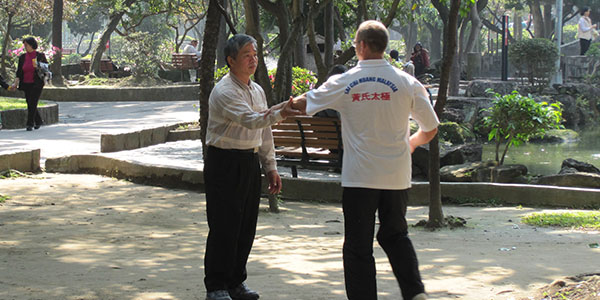
2012: Master Wu and Torben during a pushhands session in Peace Park, Taipei.
But so far we have just been experiencing the principles in our solo practice. When we start working with push hands, we will be able to experience them with a partner. Before going into the details of pushing hands I would like to make it perfectly clear that you should know when you face the other practitioner if you are practicing together or if it is a match of skill. Plainly put – are you helping each other developing your skill or are you merely determining who has the upper hand? In the following I am describing a friendly game of mutual development. When we receive force from our partner in the shape of a push towards somewhere along our centerline we should yield, follow and extend this force to the point of neutralizing it. During this process we have continuously allowed his force to pass though us and into our base, creating the power we subsequently use when we in turn issue our force onto him.
In the beginning these movements will be quite slow and the circles applied will be large and easily visible. This enables us to clearly define the various stages of Yielding, Sticking, Neutralizing and Issuing. But when time and practice have made the players proficient it would be natural to pick up speed and minimize the size of the movements up to the point where the onlooker only sees one movement. At this sophisticated level we are working with intercepting force, which is unique to Tai Ji Quan and can be refined to a level where it would seem that the practitioner uses no force at all – people simple “bump off” him when they apply force to his body. This way of developing skill is characterized by listening to yourself and your partner, by paying attention to subtle changes – “Ting Jing”.
When the Issuing is applied it gives the “victim” a soft and pleasant feeling – until he lands somewhere! As Master Sam Tam says when demonstrating his prowess in issuing with no force: “You enjoy the journey – not the destination”. But far too often you see people pushing forcibly and tearing at each other when they do push hands. This is certainly not Tai Ji Quan, not even bad Tai Ji Quan. It is slightly more sophisticated to move away from your opponent as he advances, maybe parry his punch softly and then pounce at him like some wild beast. You see a lot of that at competitions. Such people apparently pay no attention to developing their skill or refining the art, they only care about winning a contest. This is bad wrestling at best, and still not Tai Ji Quan. These so called Tai Ji Quan fighters have no level of skill and would easily be bested by any wrestler, Jiu Jitsu or Karate ka with even modest experience. Tai Ji Quan is not a sport where you win the match by counting points; it is a martial art and should be treated with sincerity and respect by the practitioners – students and teachers alike.
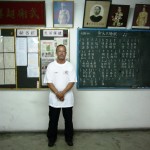
During a stay at Master Huangs school in Kuching, Malaysia 2005.
My Teachers
All my teachers have, each in their own way, helped me along to a growing understanding of and proficiency in, Tai Ji Quan. It has been decisive for me that they were on one hand able to master for themselves what they were teaching their students and on the other had a sincere wish to share their knowledge and experience. Proficiency in the art and desire and ability to teach does not always coincide. Some teachers have great martial skills but maybe no real motive for teaching except making money. Other teachers can be less skilled martial artists but have a sincere wish to share their insights with students. If I had to choose I would always pick the latter.
It is only fair that the student expects honest and truthful guidance from his teacher in return for the trust, respect and time he gives to his teacher. As a student I have always sought to create the best possible circumstances for my teachers by practicing diligently what they were trying to teach me. By making yourself an empty vessel you give the teacher a possibility to teach. No matter how skilled a teacher may be he still depends on his student’s ability to listen with a clear and open mind and on their willingness to practice. Just hanging out with a master won’t cut it, hoping his skill and understanding will somehow rub of onto you.
Everything worth learning takes hard work to learn and in this respect Tai Ji Quan is no different. I am profoundly grateful for the patience and enthusiasm all my teachers have shown when teaching me. Each one has contributed with something significant that gave the following Master a possibility to refine and deepen my skill and understanding.
I would like to single out three masters.
Master He Gong De – my Lao Jia Chen Style teacher made a tremendous effort to teach me his art, both the Chen style, but also Qi Gong and Tai Ji Quan in general.He spent hours, days and months through a period of 5 years to make sure I actually understood what he was trying to teach me.
Master Wee Kee Jin, who spent countless hours during a 10 year period selflessly and patiently trying to teach me Master Huangs Tai Ji Quan, correcting me and guiding me when it was necessary.
And last but not least, Master Sam Tam. Master Sam Tam is undoubtedly one of the most proficient masters of internal martial arts in the world today. He will with ease demonstrate every aspect of the internal martial art and, uniquely he can as easily show the difference between internal and external martial arts through his superior skills in Eagle Claw, Yi Quan and Tai Ji Quan. I am very grateful for the way he has accepted me as his student, pouring from his vast knowledge and for the way he and his wife Amy has opened their home to me.

2014: Sam Tam and Torben at a workshop in Copenhagen
All of these three masters have had a sincere wish to share and for that I am very much obliged. Having Masters such as these; with deep knowledge, practical mastery and a wish to teach is surely the ideal position for any sincere student. All you have to do is empty your mind and practice what is taught, staying a student eager to learn! As Sam Tam says concerning teaching “either you decide to teach a student or you don’t, there can be no in between”.
Torben Bremann